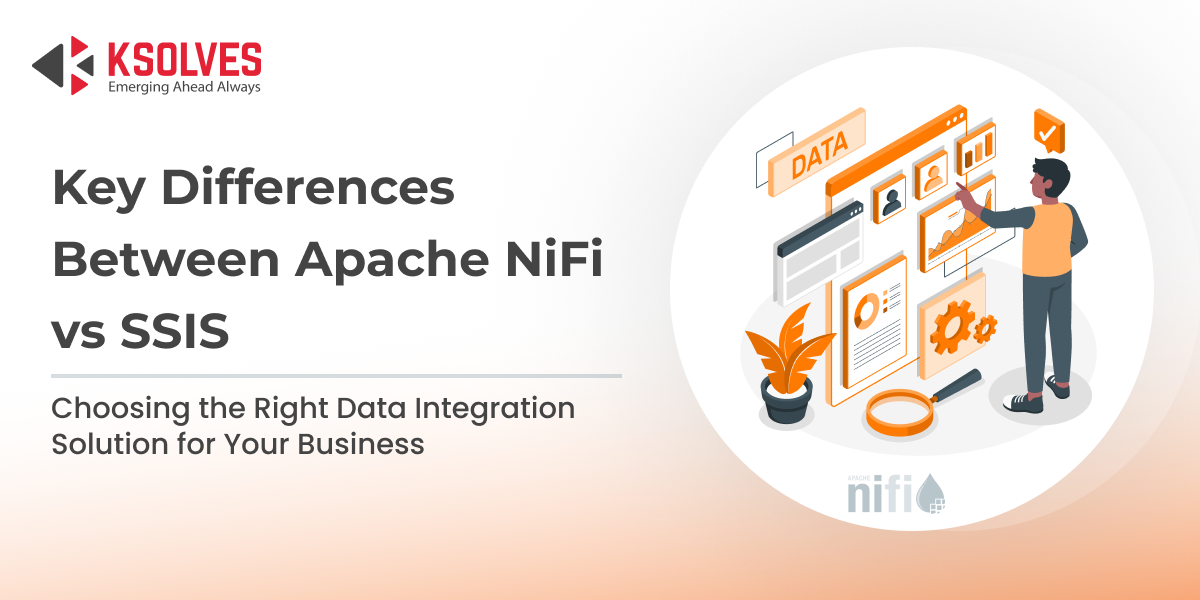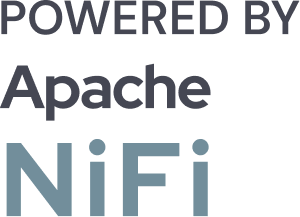Apache NiFi vs SSIS – Which is the Right Data Integration Solution for Your Business?
![]()

In today’s hyper-connected world, every business, no matter the industry, relies on data to make decisions, automate processes, and deliver personalized experiences. But while data is abundant, managing its flow between systems efficiently is where the real challenge lies. That’s where data integration tools come into play.
Two of the most widely adopted solutions in this space are Apache NiFi and Microsoft SQL Server Integration Services (SSIS). Apache NiFi is an open-source, flow-based platform designed for real-time, event-driven data movement, ideal for modern, distributed architectures. In contrast, SSIS is a mature, enterprise-grade ETL solution tailored for batch data processing within the Microsoft ecosystem.
Both tools are powerful, but they cater to different integration styles, technical environments, and business use cases.
In this blog, we’ll walk you through Apache NiFi and SSIS comparison, from architecture and features to use cases and deployment models, to help you decide which data integration solution best aligns with your business goals.
What is Apache NiFi?
Apache NiFi is an open-source data integration tool developed by the Apache Software Foundation. Designed to automate and manage the flow of data between systems, NiFi supports real-time data ingestion, transformation, and routing through its powerful, web-based user interface. With its visual flow-based programming model and drag-and-drop interface, it’s ideal for working with complex data flows.
Apache NiFi architecture is based on the concepts of flowfiles, processors, and connections. It offers built-in support for data lineage, provenance, back pressure, and fine-grained access control.
What is Microsoft SSIS?
Microsoft SQL Server Integration Services (SSIS) is a component of the Microsoft SQL Server database software that performs data migration and workflow solutions. SSIS enables data extraction, transformation, and loading (ETL) primarily within the Microsoft ecosystem. It’s a widely used enterprise ETL tool with a mature feature set that includes integration with SQL Server, data warehousing support, and compatibility with Visual Studio.
SSIS is often favored in environments where SQL Server is the core database platform and Microsoft technologies are widely adopted.
Apache NiFi vs SSIS – A Head-to-Head Comparison
| Parameters | Apache NiFi | Microsoft SSIS |
| Tool Type | Open-source data integration and flow automation platform | Proprietary ETL tool from Microsoft |
| Data Processing Style | Real-time, event-driven, stream-based processing | Batch-oriented ETL processing |
| User Interface | Web-based, drag-and-drop flow designer | Visual Studio-based designer with drag-and-drop components |
| Deployment Environment | Cross-platform (Linux, Windows, macOS); supports containerization and clustering | Primarily Windows-based, integrated with SQL Server |
| Scalability | Highly scalable for large, distributed data flows | Scales well within Microsoft infrastructure, but is limited outside it |
| Ease of Use | Intuitive for flow-based logic, but may require effort for complex transformations | Easier for traditional ETL users, especially in Microsoft-heavy teams |
| Integration Ecosystem | Supports a wide range of systems, protocols (Kafka, MQTT, FTP, APIs, etc.) | Best suited for the Microsoft stack (SQL Server, Azure, Excel, etc.) |
| Transformation Capabilities | Good for routing, filtering, lightweight transformations; not ideal for complex logic | Strong capabilities for complex ETL operations, lookups, joins, transformations |
| Monitoring & Provenance | Built-in data provenance tracking for full auditability | Logging through SSIS logging providers, less granular than NiFi |
| Error Handling & Recovery | Robust with automatic retries, backpressure, and failure routing | Supports event handlers, but recovery mechanisms require custom handling |
| Security | Supports SSL, user authentication, and policy-based access control | Integrated with Windows authentication and role-based security |
| Learning Curve | Moderate; easier for those familiar with flow-based paradigms | Moderate to high; easier for those already in Microsoft environments |
Apache NiFi vs SSIS – Key Features
Apache NiFi Features
- Flow-Based Programming Interface: Design data pipelines visually using a web UI, connecting processors like building blocks.
- Real-Time Streaming and Event-Driven Processing: Designed for handling continuous data streams and real-time ingestion from multiple sources.
- Built-in Data Provenance: Track every movement and transformation of data, which is crucial for audit and compliance.
- Backpressure and Prioritization: Control data flow rates and queue limits to prevent overloading downstream systems.
- Extensive Connectivity: Supports a wide range of protocols and formats—HTTP, FTP, MQTT, Kafka, HDFS, and more.
- Clustering and Scalability: Easily scales horizontally with NiFi clusters for high-volume, distributed data processing.
- Secure and Configurable: Offers fine-grained user access control, SSL/TLS encryption, and policy-based permissions.
- Template-Based Reusability: Create reusable templates for faster development and deployment of flows.
Microsoft SSIS Features
- Visual Development in Visual Studio: Build ETL workflows with a drag-and-drop interface using SQL Server Data Tools (SSDT).
- Strong ETL Capabilities: Ideal for complex data transformations, lookups, aggregations, and conditional logic.
- Tight Integration with Microsoft Ecosystem: Seamless integration with SQL Server, Excel, Azure, SharePoint, and other Microsoft services.
- Built-in Control Flow and Data Flow: Separate control and data workflows for greater flexibility in job design.
- Pre-built Connectors and Adapters: Out-of-the-box connectors for popular databases, files, and enterprise applications.
- Error Handling and Debugging Tools: Event handlers, breakpoints, and data viewers make it easier to manage and troubleshoot jobs.
- Package Deployment and Configuration: Centralized deployment with options for environment-specific configurations.
- Security with Windows Authentication: Leverages Windows Active Directory for user and permission management.
Apache NiFi vs SSIS – Pros and Cons
Pros of Apache NiFi
- Real-time data flow: Perfect for stream processing and handling continuous data in motion.
- Highly flexible and extensible: Works with a wide range of protocols and data formats.
- Built-in data lineage tracking: Full transparency with data provenance for auditing and compliance.
- Easy-to-use visual interface: Drag-and-drop UI helps design and monitor complex pipelines with ease.
- Scalable architecture: Supports clustering for high availability and load balancing.
- Open source: No licensing cost, with active community support and frequent updates.
Cons of Apache NiFi
- Limited in complex transformations: Not the best choice for heavy data aggregation or deep transformations.
- Basic governance features: Lacks built-in data quality or metadata management tools.
- Manual environment promotion: Moving flows across environments (Dev, Test, Prod) needs extra tools or custom scripting.
- Can get visually cluttered: Large flows can become difficult to manage without proper organization.
- Learning curve for advanced configurations: Requires understanding of flowfile attributes, processors, and backpressure logic.
Pros of Microsoft SSIS
- Great for structured data processing: Ideal for batch data integration and data warehousing.
- Strong transformation capabilities: Handles complex business logic, joins, and aggregations easily.
- Seamless with Microsoft stack: Best suited for organizations already using SQL Server and other Microsoft tools.
- Robust error handling: Includes built-in event handling and debugging tools.
- Mature and reliable: Proven track record with years of enterprise adoption and support.
- Integrated development environment: Uses Visual Studio with familiar tools for developers.
Cons of Microsoft SSIS
- Not real-time focused: Primarily designed for scheduled, batch-based ETL workflows.
- Windows-centric: Limited compatibility outside the Microsoft ecosystem.
- Licensing cost: Requires SQL Server licensing, which can be costly for large deployments.
- Limited protocol and source flexibility: Lacks native support for modern protocols like Kafka, MQTT, or cloud-native services.
- Less intuitive for non-Microsoft users: Can be challenging for teams not already embedded in Microsoft infrastructure.
Apache NiFi vs SSIS – Use Cases
Apache NiFi Use Cases
- Real-time data ingestion from IoT devices, sensors, APIs, etc.
- Stream data to Kafka or cloud storage (S3, GCS, etc.).
- Log aggregation for centralized monitoring (e.g., ELK stack).
- Hybrid cloud data movement between on-prem and cloud systems.
- IoT and edge data integration using protocols like MQTT.
- Data lake ingestion for big data platforms like Hadoop or AWS S3.
Read more- Apache NiFi Overview: Key Benefits and Features
Microsoft SSIS Use Cases
- Batch ETL for loading data into SQL Server or data warehouses.
- Data migration from legacy systems to modern SQL-based platforms.
- Scheduled data integration from Excel, CRM, ERP, or flat files.
- Data cleaning and standardization with built-in transformation tools.
- BI and reporting feeds for tools like Power BI and SSRS.
- Seamless Microsoft ecosystem integration for Azure and on-prem tools.
Which is better for ETL: SSIS or Apache NiFi?
SSIS (SQL Server Integration Services) is generally the better choice for traditional ETL (Extract, Transform, Load) workflows, especially when:
- You’re working with structured, relational data (like SQL Server, Oracle, Excel).
- You need complex transformations and control flow logic.
- Your ETL jobs are scheduled in batches (daily, hourly, etc.).
- You’re using the Microsoft ecosystem (Power BI, Azure, etc.).
Apache NiFi is better suited for modern ETL pipelines where:
- You need to process real-time or streaming data (IoT, sensors, logs).
- Data comes from multiple protocols and sources (APIs, Kafka, MQTT, FTP).
- Your workflows are event-driven or require flow-based automation.
- You need data routing, filtering, and enrichment, rather than deep transformations.
Conclusion
Both Apache NiFi and SSIS are powerful data integration tools, but the right choice ultimately depends on your business needs. NiFi excels in real-time data ingestion, flexibility across diverse systems, and streaming architectures, making it ideal for modern, event-driven environments. On the other hand, SSIS remains a top choice for organizations leveraging the Microsoft ecosystem, focusing on batch ETL processes and structured data workflows.
Carefully assess your project requirements—whether it’s handling real-time data streams, cloud integrations, or traditional data pipelines—before making a decision. And if you’re looking to enhance your NiFi data flow creation, deployments, and promotion for an on-premise environment, tools like Data Flow Manager can help streamline the process.
![]()

